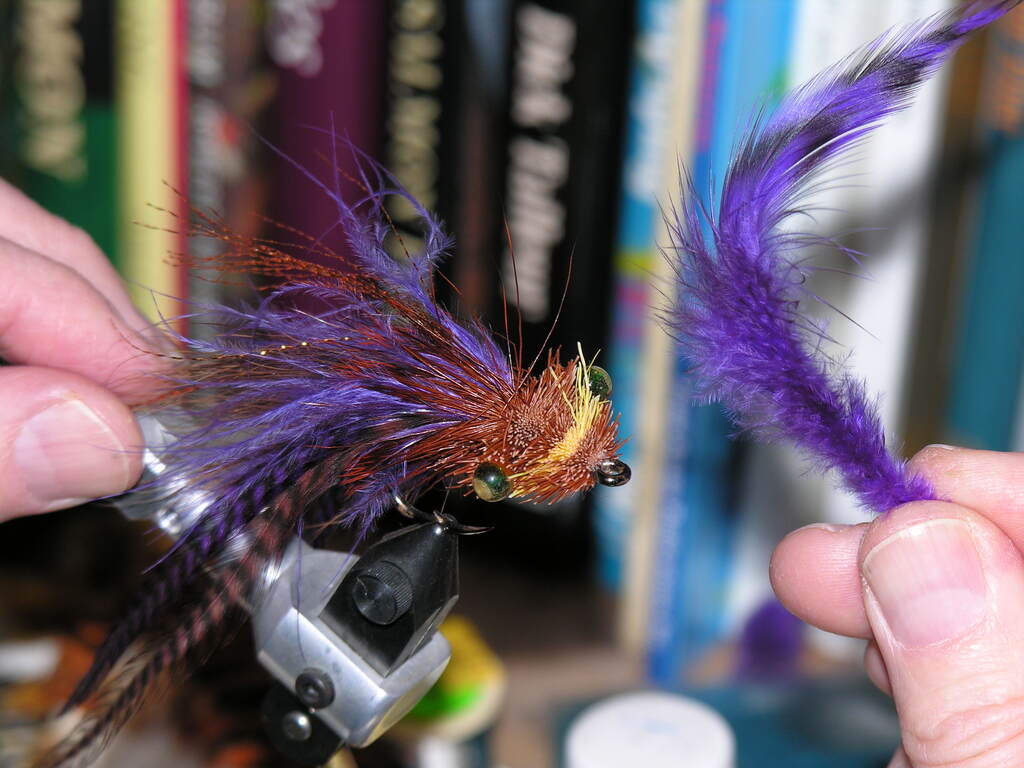
There are dozens of valid reasons for Aroostook anglers to tie flies. Regardless of age, kids, women and men can learn how to cobble together hooks, feathers, fur, floss and other materials to create an insect imitation that will fool a hungry fish.
For many Crown of Maine sportsmen, cold-weather fly tying offers a viable link with summer and time on a favorite lake or stream. This hobby fights off cabin fever and winter blahs while giving us something to look forward to in a couple of months.
I learned to tie flies from my dad and my cousin Steve Hitchcock when I was about 12 years old and have been enjoying the pastime ever since. My first attempts were wet flies and streamers, simple patterns and easy to build with minimal materials. Over the years I’ve expanded my repertoire to dry flies, nymphs, tandem streamers, bass bugs, salmon flies and salt water patterns. The culmination of years of practice at the fly bench and vise are my classic salmon patterns tied with dozens of unique and often rare feathers and fur. One fly can take a total of two to four hours to complete.
Beyond the gratification and pleasure of passing many a cold winter evening, there’s the satisfaction of actually catching a fish on a fly you personally tied. Even more rewarding is the feat of inventing and then constructing a fly pattern from your own imagination, and then actually catching fish with your creation. This hobby also keeps personal fly boxes well supplied with patterns and sizes that may not be available at local stores, and saves money while offering great entertainment and satisfaction.

It’s only a couple of months or so before spring fishing season will finally arrive and it makes the author feel better about all the snow to tie a few streamer flies on a cold winter night. (Courtesy of Bill Graves)
Roughly 75 years ago, my dad and his brother Vincent combined ideas to construct a streamer fly for trout. After a few attempts and a couple of alterations in color and materials, they named their yellow, white and gold creation Jasbo. Few people have one or have ever seen it, as it was kind of a family secret weapon. I have tied and used this fly pattern since I began fly fishing, and it still catches trout and salmon when most other patterns fail.
Every well known fly pattern began as some random fisherman’s idea that turned into reality at a fly-tying bench. Thousands of patterns turned out so-so and worked occasionally, but a few become famous and world renowned for regularly catching certain species of game fish. Who knows? Maybe you can learn a new hobby and create Aroostook’s newest trout-catching sensation.
At the very least, flytiers not only have a pastime but always a full fly box without having to go to a sporting goods store and spend top dollar. Sometimes a fly shop doesn’t have the pattern or hook size an angler needs, but a flytier can build his own in just a few minutes. There are kits for sale with all the basic equipment, hooks and materials included to tie a dozen or so patterns. There are boxed sets dedicated to a specific style of fishing fly — dry, wet, streamer, nymph and so on — to meet specific needs. Some larger versions are compilations, a bit larger with a wider range of materials and hooks to construct several styles and multiple patterns. There’s a specific pattern style and reasonable price range for all beginners attempting a new hobby.

Winter is a perfect time to spend an evening at the fly tying vise and whip together a few dry flies to refill your box for the upcoming season. (Courtesy of Bill Graves)
The actual hands-on learning process of tying flies may be accomplished in several ways. By far the fastest and most practical method is one-on-one instruction by family or friends who have a fly bench set up with a wide selection of equipment and materials. Some rod and gun clubs, fly shops, or even continuing education programs at local schools offer group classes for a nominal fee and provide all gear and components. This is a great way for family members to learn and enjoy fly tying together, but current COVID-19 conditions have greatly reduced and limited this option. You would be amazed by the number of YouTube and online videos as well as podcasts available.
If none of these opportunities are available in your area, then turn to books and videos. A truckload of well illustrated books and magazines, DVDs and tapes offer step-by-step fly tying instructions to everyone from the first-time novice to more advanced intermediate tiers. In every case it’s practice that produces effective, high quality fishing flies.
I will say however, from personal experience and stories from friends, sometimes fish will devour any fly, even if it resembles a hairball the cat coughed up. Don’t be discouraged with early results. Some will catch fish, and in a few months your flies will be realistic enough to fool even the most finicky finned quarry.
There are two months of winter ahead of us, plenty of time to begin and enjoy a practical pastime. Many days the weather deters even the hardiest sportsman from ice fishing or rabbit hunting, or perhaps you’ve had enough for awhile and want to relax inside the warm house.
It’s amazing how comfortable and calming an hour at the fly vise can be, and while your hands are working your mind can look ahead to the warm weather and inviting brook where the fly your building may be successfully presented to waiting trout. Time flies when you tie flies.






